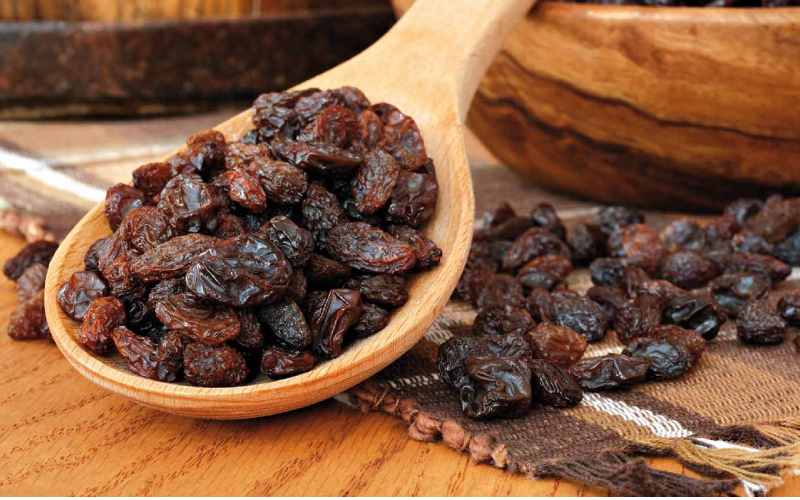
Raisins, the sweet and naturally dried fruit, are not only one of the most popular dried fruits in Iran and worldwide, but are also rich in energy, fiber, iron, and antioxidants. With its diverse climate and vast vineyards, Iran is one of the largest producers of raisins in the world. The wide variety of Iranian raisins makes them a top choice in both domestic and export markets.
Below, you’ll find an overview of the different types of Iranian raisins and the unique characteristics of each:
1. Kashmari Long Green Raisins
These raisins are produced from green grapes using a traditional shade-drying method. They are rich in nutrients, fiber, potassium, and magnesium, which help improve digestion, prevent heart disease, and detoxify the body.
Characteristics:
* Light olive green color
* Long and shiny shape
* Naturally sweet taste
* Seedless
Production Method:
This raisin is traditionally dried in the shade to preserve its natural color and softness. No chemicals or sulfur are used.
Uses:
* Premium and luxury nut mixes
* Healthy snacks
* Formal servings
* Export packaging
Export Value:
Its distinct appearance and authentic taste make it highly popular in Arab countries, India, Malaysia, and the UAE.
2. Golden Raisins (Angoori / Californian)
This variety is dried using an alkaline solution (dip) and sulfur smoke, resulting in a golden amber color. It has a high shelf life, making it suitable for export. However, using chemicals may reduce some of its natural benefits and pose minor health concerns.
Characteristics:
* Bright golden yellow color
* Sweet and mild flavor
* Seedless
* Soft and palatable texture
Production Method:
Seedless white grapes are washed and dried using sulfur smoke to enhance shelf life and create a visually appealing golden color.
Uses:
* Export-grade nut mixes
* Baking and confectionery
* Supermarket packaging
* Ready-to-eat food products
Export Value:
Due to its premium appearance and soft texture, it is widely exported to Europe, Russia, China, and the Persian Gulf countries.
3. Cooking Raisins (Poloee)
These dark brown raisins with a balanced taste are commonly used in Persian rice dishes. They are usually sautéed in oil before being added to food to enhance their flavor and aroma.
Characteristics:
* Dark brown color
* Medium size
* Mildly sweet flavor
* Seedless
Production Method:
Made from seedless white grapes and dried either using the alkaline dip method or sun-drying to speed up the process and increase shelf life.
Uses:
* Cooking traditional Iranian dishes like Adas Polo, Shirin Polo, and Lubia Polo
* Household and restaurant use
* Bulk packaging for food industries
Export Value:
Due to its widespread culinary use and affordable price, it is among the best-selling exported raisins to Iraq, Afghanistan, Pakistan, and Central Asia.
4. Sun-Dried Raisins
Naturally dried under direct sunlight, these raisins have a reddish-brown color and retain a sweet, unprocessed flavor, rich in vitamins.
Characteristics:
* Light to dark brown color
* All-natural taste with no additives
* Relatively dry and dense texture
* Seedless
Production Method:
Seedless grapes are sun-dried naturally without any chemicals or sulfur.
Uses:
* Healthy and natural diets
* Traditional dried fruit assortments
* Organic food markets
* Suitable for special dietary needs
Export Value:
Due to its additive-free production, it is highly favored in European, Canadian, Japanese, and German markets that prioritize organic products.
5. Black Raisins (Maviz)
Produced from large, black grapes, this raisin is valued for its therapeutic benefits and is highly recommended in traditional medicine.
Characteristics:
* Black or dark brown color
* Seeded or seedless
* Large-sized berries
* Highly nutritious, rich in iron and antioxidants
Production Method:
Made from Shahan or Asgari grape varieties and dried naturally in sunlight.
Uses:
* Enhances memory, helps combat anemia
* Healthy snacks for children and the elderly
* Used in traditional medicine
* Energy-boosting dried fruit mixes
Export Value:
Popular in Russia, Turkey, Armenia, Iraq, and Eastern Europe as a medicinal and nourishing product.
6. Sultana Raisins
Sultana raisins are one of the most widely used and exported types of Iranian raisins. Known globally as “Sultana Raisins,” their sweet taste, amber color, and versatility in the food industry make them a strategic export product.
Characteristics:
* Light brown to golden color
* Soft and uniform texture
* Mild and sweet taste
* Seedless
Production Method:
Produced from white grapes and dried using either the alkaline dip or sulfur method, depending on the target market.
Uses:
* Food industries (cakes, biscuits, granola)
* Mixed nut assortments
* Export packaging
* Daily consumption
Export Value:
As one of Iran’s top export raisins, Sultanas are sold under this name in markets across Europe, the U.S., Russia, China, and Australia.
written by: Sara Ebrahimi
















